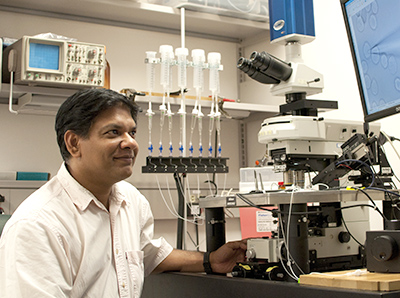In his laboratory, Bikash Pattnaik, PhD, investigates potassium channel mutations in retinal cells—mutations that are associated with Leber Congenital Amaurosis (LCA), a genetic disease that causes blindness at birth.
Now, thanks to a $1 million-plus gift in support of Dr. Pattnaik’s research, the study of novel therapy approaches for the disease is expanding.
A New Variation on a Genetic Disease

LCA is an inherited disease that, according to GeneReviewsTM, affects two to three in 100,000 children. It is the cause of blindness for more than 20 percent of children who attend schools for the blind.
Until recently, there were 15 known genetic variations of LCA. One variation, LCA2, which is caused by a gene mutation in the retinal pigment epithelium (RPE) protein RPE65, has been successfully treated with gene replacement therapy in recent clinical trials.
In 2011, scientists in England identified a new form of the disease, LCA16, which is associated with a gene mutation in an RPE potassium channel.
That’s where Dr. Pattnaik comes in. His lab studies the molecular mechanisms of potassium channel function, and aims to identify novel therapies for restoring that function in patients with LCA16.
Collaborations and Donations
To further his research, however, Dr. Pattnaik needed to identify patients who have the LCA16 potassium channel mutation, and who could make cell samples available for analysis and testing.
To accomplish this, he began forging collaborations with LCA experts in the United States and England, including John Chiang, PhD, and his team at the Casey Eye Institute in Portland, Oregon, which provides diagnostic testing for genetic diseases of the eye.
In early 2013, through CEI, Dr. Pattnaik made a connection with a family who had read his papers. The family in turn expressed interest in supporting his research.
“The family’s generous donation, and the recommendations of my collaborators David Gamm, MD, PhD, at the University of Wisconsin, and Willliam Hauswirth, PhD, at the University of Florida, is what is allowing this research to get underway quickly,” Dr. Pattnaik said. “I’m very grateful to all of them for their support.”
Developing a Therapy
The study, which uses cultured mammalian and human cells and cultured RPE stem cells from the patient in a mouse model, has three primary goals.
First, it aims to identify a “read-through” drug that can effectively overcome the potassium channel defect caused by the LCA16 gene mutation. Second, it aims to successfully make and test RPE stem cells from the patient and unaffected siblings. Finally, it aims to develop and test a viral vector to deliver the corrected gene for therapeutic use.
“Over the next three years, we hope to determine the best therapy approach that could be considered for a clinical trial,” Dr. Pattnaik said.
Dr. Pattnaik also emphasized how the study demonstrates the value of personalized medicine and collaborations between clinicians and researchers.
“This patient had seen several ophthalmologists before his family approached CEI and ultimately my laboratory,” he explained. “It’s helpful for clinicians to have basic science partners: the two-way communication benefits them and their patients.”
Thanks to the UW Department of Pediatrics, the UW McPherson Eye Research Institute, and the UW Institute for Clinical and Translational Research for providing seed funding for initial laboratory work on potassium channelopathy.